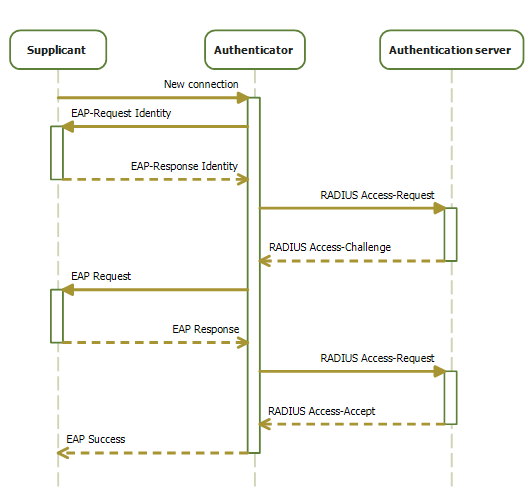SystemBabble.github.io
A place for notes and stuff
WPA2-802.1x/Enterprise Mode on OpenWrt tiny devices
OpenWrt v18.06, 19.07
A while ago I wanted to get wireless enterprise authentication going. I have a dirt cheap ($15-20) TP-Link TL-WR841N v11 with support for 15 vlans.
wpad is a single package that provides the functionality of hostapd and wpa_supplicant. wpad-mini is installed with OpenWrt by default for space saving reasons, but either the full version of wpad, or hostapd is required for the access point to act as an authenticator.
This article is going to focus on the AP that acts as an 802.1x authenticator.

Image by Felix Bauer / CC BY-SA
See https://sysramble.github.io/topics/freeradius for FreeRADIUS configuration, if you need an authentication server.
Firmware
Because of space constraints on the TL-WR841N, there is no space for opkg to install wpad. Building your own firmware image is required.
https://openwrt.org/docs/guide-user/additional-software/saving_space
In short run make menuconfig remove the
ppp, iptables, odhcp, opkg, hostapd-mini packages and add wpad-openssl
Don’t add the LuCI GUI and instead use ssh to configure the device.
Prebuilt images for v19.07.02 are below.
Use at your own risk: bin/targets/ath79/tiny/
- OpenWrt v19.07.02
- tplink_tl-wr841-v11
- ath79-tiny target
- No LuCi only Dropbear
- No iptables, ppp or opkg
- Full wpad-openssl
Configuration
There are two main configuration areas to worry about. network and wireless
Network
This file defines the network interface configuration. Define ip addresses, vlans, routes and switch configuration here.
Interfaces
In the example file there are 3 vlan interfaces
vlan2 the ‘administrative’ vlan, this will carry radius traffic and other protocols such as ntp and ssh, and serve as the default route vlan.
# administrative vlan
config interface 'vlan2'
option type 'bridge'
option ifname 'eth0.2'
option proto 'static'
option ipaddr '10.1.2.2'
option netmask '255.255.255.0'
option stp '1'
option igmp_snooping '1'
# default route to admin vlan
config 'route'
option 'interface' 'vlan2'
option 'target' '0.0.0.0'
option 'netmask' '0.0.0.0'
option 'gateway' '10.1.2.1'
option 'metric' 0
vlan3 the ‘default’ vlan, this vlan will be assigned to clients that pass EAP authentication but do not get assigned another vlan. Note: the server not the authenticator will assign the supplicant the default vlan.
config interface 'vlan3'
option type 'bridge'
option ifname 'eth0.3'
option proto 'static'
option ipaddr '10.1.3.2'
option netmask '255.255.255.0'
option stp '1'
option igmp_snooping '1'
vlan4 and so on would be assigned to clients by the radius server response.
config interface 'vlan4'
option type 'bridge'
option ifname 'eth0.4'
option proto 'static'
option ipaddr '10.1.4.2'
option netmask '255.255.255.248'
option stp '1'
option igmp_snooping '1'
Switch configuration
# enable vlans
config switch
option name 'switch0'
option reset '1'
option enable_vlan '1'
For each vlan, decide which ports are tagged and untagged.
# vlan2 tagged on 1 2 4 and 0, and untagged on 3
config switch_vlan
option device 'switch0'
option vlan '2'
option ports '1t 2t 3 4t 0t'
# vlan3 tagged on 1 4 and 0
config switch_vlan
option device 'switch0'
option vlan '3'
option ports '1t 4t 0t'
Wirless
The key used here authenticates the authenticator to the radius server and should be strong 22 character password. You can generate an appropriate 128 bit key like this.
dd if=/dev/urandom bs=16 count=1 | base64 | sed -e "s/=//g"
Note: generating keys on embedded devices with low entropy might lead to predictable keys.
config wifi-device 'radio0'
option type 'mac80211'
option channel 'auto'
option hwmode '11g'
option path 'platform/qca953x_wmac'
option htmode 'HT20'
#option txpower '10'
option country 'CA'
option legacy_rates '0'
#option distance '25'
option disabled '0'
config wifi-iface 'enterprise_radio0'
option device 'radio0'
option mode 'ap'
option ssid 'systembabble'
option encryption 'wpa2+aes' # WPA2-802.1x
option server '10.1.2.2' # FreeRADIUS server ip
option port '1812'
option key 'lJAMZ5qavNSLuyt4UF5wwg' # should be 22 chars of random
# helps protect against KRACK
option wpa_disable_eapol_key_retries '1'
# pmksa key caching
option auth_cache '1'
# protected management frames
#option ieee80211w '1' # this can cause problems with older iPhones
# prohibit tunneled direct link setup
option tdls_probibit '1'
# 0 disabled / 1 enabled / 2 VLAN tunnel attribute mandatory
option dynamic_vlan '2'
option vlan_tagged_interface 'eth0'
option vlan_bridge 'br-vlan'
# 0 is vlan1 vlan2 / 1 is eth0.1 eth0.2
option vlan_naming '0'
At this point if you have the RADIUS server set up you should be ready to start authenticating clients!
Note about ssh
Dropbear has an odd bug on MIPS16 where it hangs when you try and ssh into a device. Just Ctrl+C and try 4 times and it will work on the 3rd or 4th attempt.
https://dev.archive.openwrt.org/ticket/15209 https://forum.archive.openwrt.org/viewtopic.php?id=70368&p=1#p355173